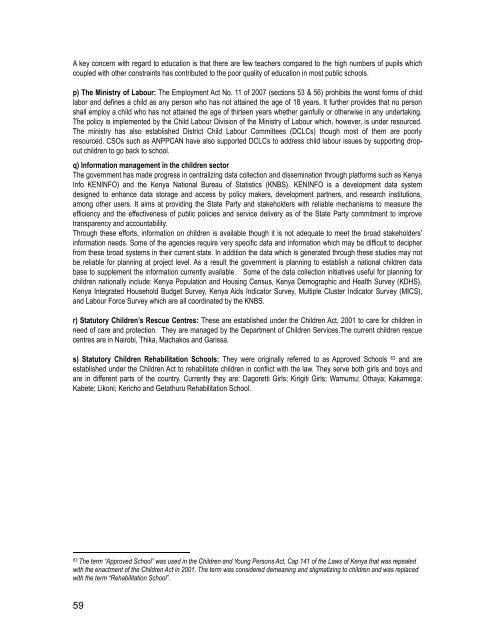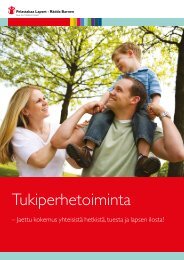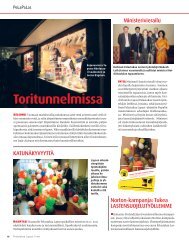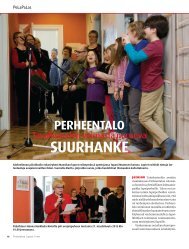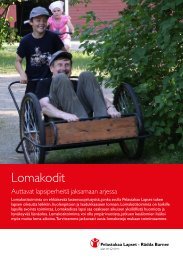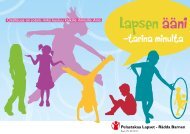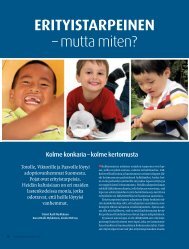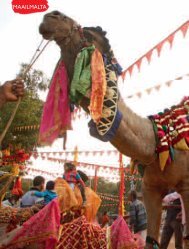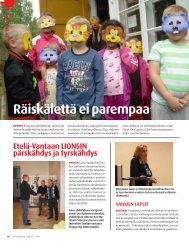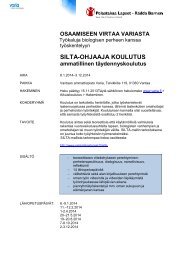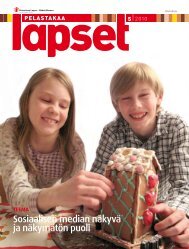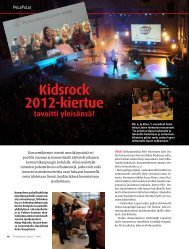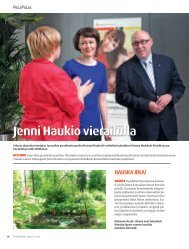Promoting child rights in Kenya - Pelastakaa Lapset ry
Promoting child rights in Kenya - Pelastakaa Lapset ry
Promoting child rights in Kenya - Pelastakaa Lapset ry
You also want an ePaper? Increase the reach of your titles
YUMPU automatically turns print PDFs into web optimized ePapers that Google loves.
A key concern with regard to education is that there are few teachers compared to the high numbers of pupils whichcoupled with other constra<strong>in</strong>ts has contributed to the poor quality of education <strong>in</strong> most public schools.p) The M<strong>in</strong>ist<strong>ry</strong> of Labour: The Employment Act No. 11 of 2007 (sections 53 & 56) prohibits the worst forms of <strong>child</strong>labor and def<strong>in</strong>es a <strong>child</strong> as any person who has not atta<strong>in</strong>ed the age of 18 years. It further provides that no personshall employ a <strong>child</strong> who has not atta<strong>in</strong>ed the age of thirteen years whether ga<strong>in</strong>fully or otherwise <strong>in</strong> any undertak<strong>in</strong>g.The policy is implemented by the Child Labour Division of the M<strong>in</strong>ist<strong>ry</strong> of Labour which, however, is under resourced.The m<strong>in</strong>ist<strong>ry</strong> has also established District Child Labour Committees (DCLCs) though most of them are poorlyresourced. CSOs such as ANPPCAN have also supported DCLCs to address <strong>child</strong> labour issues by support<strong>in</strong>g dropout<strong>child</strong>ren to go back to school.q) Information management <strong>in</strong> the <strong>child</strong>ren sectorThe government has made progress <strong>in</strong> centraliz<strong>in</strong>g data collection and dissem<strong>in</strong>ation through platforms such as <strong>Kenya</strong>Info KENINFO) and the <strong>Kenya</strong> National Bureau of Statistics (KNBS). KENINFO is a development data systemdesigned to enhance data storage and access by policy makers, development partners, and research <strong>in</strong>stitutions,among other users. It aims at provid<strong>in</strong>g the State Party and stakeholders with reliable mechanisms to measure theefficiency and the effectiveness of public policies and service delive<strong>ry</strong> as of the State Party commitment to improvetransparency and accountability.Through these efforts, <strong>in</strong>formation on <strong>child</strong>ren is available though it is not adequate to meet the broad stakeholders’<strong>in</strong>formation needs. Some of the agencies require ve<strong>ry</strong> specific data and <strong>in</strong>formation which may be difficult to decipherfrom these broad systems <strong>in</strong> their current state. In addition the data which is generated through these studies may notbe reliable for plann<strong>in</strong>g at project level. As a result the government is plann<strong>in</strong>g to establish a national <strong>child</strong>ren database to supplement the <strong>in</strong>formation currently available. Some of the data collection <strong>in</strong>itiatives useful for plann<strong>in</strong>g for<strong>child</strong>ren nationally <strong>in</strong>clude: <strong>Kenya</strong> Population and Hous<strong>in</strong>g Census, <strong>Kenya</strong> Demographic and Health Survey (KDHS),<strong>Kenya</strong> Integrated Household Budget Survey, <strong>Kenya</strong> Aids Indicator Survey, Multiple Cluster Indicator Survey (MICS),and Labour Force Survey which are all coord<strong>in</strong>ated by the KNBS.r) Statuto<strong>ry</strong> Children’s Rescue Centres: These are established under the Children Act, 2001 to care for <strong>child</strong>ren <strong>in</strong>need of care and protection. They are managed by the Department of Children Services.The current <strong>child</strong>ren rescuecentres are <strong>in</strong> Nairobi, Thika, Machakos and Garissa.s) Statuto<strong>ry</strong> Children Rehabilitation Schools: They were orig<strong>in</strong>ally referred to as Approved Schools 63 and areestablished under the Children Act to rehabilitate <strong>child</strong>ren <strong>in</strong> conflict with the law. They serve both girls and boys andare <strong>in</strong> different parts of the count<strong>ry</strong>. Currently they are: Dagoretti Girls; Kirigiti Girls; Wamumu; Othaya; Kakamega;Kabete; Likoni; Kericho and Getathuru Rehabilitation School.63The term “Approved School” was used <strong>in</strong> the Children and Young Persons Act, Cap 141 of the Laws of <strong>Kenya</strong> that was repealedwith the enactment of the Children Act <strong>in</strong> 2001. The term was considered demean<strong>in</strong>g and stigmatiz<strong>in</strong>g to <strong>child</strong>ren and was replacedwith the term “Rehabilitation School”.59


